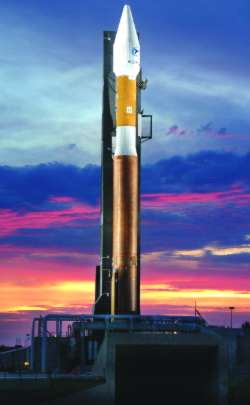|
|
|
|
|
Atlas V Flies, But Will It Sell?CRAIG COVAULT/CAPE CANAVERAL The successful flight test must be matched The Lockheed Martin Atlas V evolved expendable launch vehicle has succeeded in its first flight test, but now must pass an equally challenging market test, based on cost as well as flight performance.
International Launch Services (ILS) which sells the Atlas and Russian Proton said there were 30 firm orders for the new launcher before its first flight, with the likelihood of additional orders once the vehicle proved itself. This compares with about 50 orders for its Boeing Delta IV competitor. The Atlas V launched the Eutelsat/Alcatel Hot Bird 6. Five or six potential Atlas V customers were in a "wait-and-see" mode prior to the Aug. 21 first flight. ILS managers said they hoped to have at least one of these in the Atlas V camp by the end of the month. The Atlas V team is also awaiting a U.S. Air Force decision about whether it will pull a Defense Satellite Communications System (DSCS) payload off the Delta IV EELV and shift it to Atlas because of Delta IV launch delays. The first Delta IV launch carrying the Eutelsat/Alcatel W5 spacecraft has been postponed until at least Nov. 3. The DSCS was to have been launched by December under the original plan. The second Atlas V is scheduled for launch in December carrying a Telesat Canada spacecraft, and ILS managers said they could also fit in the DSCS mission before the end of 2002 or early 2003 if requested by the Air Force. The first flight of the Atlas V is documented here by Aviation Week
& Space Technology photographer Carleton Bailie and photographers
from Lockheed Martin and Bionetics Photo Services, Lockheed Martin's
engineering photo contractor at Cape Canaveral.
© September 16, 2002 The McGraw-Hill Companies Inc. Correspondence
| Market
Focus | Industry
Outlook |


.jpg)
.jpg)
.jpg)
.jpg)
.jpg)
.jpg)